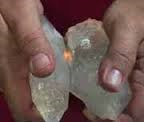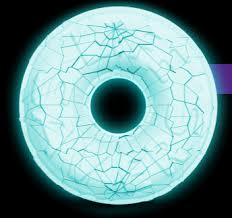Overview
Some materials give off sparks of light when they are rubbed, crushed, or broken. This phenomenon is known as triboluminescence or fractoluminescence. It may hold clues to how changes in pressure produce chemical reactions.
Quartz and Sugar Crystals
Quartz is a mineral that forms very large crystals. Centuries ago, it was used in ceremonies where quartz crystals were rubbed together to create sparks of light, an eerie effect in the darkness. Diamonds also glow when they are rubbed or cut. It is also seen when sugar cubes are rubbed together. Scientists noticed in the 1790s that sparks flew when bits of sugar were chipped off in dim light, so that the sparks were visible.
|
Figure 1: When quartz crystals are rubbed together, the flash of light that is produced is an example of triboluminescence. |
Adhesive Tape
Adhesive tape is also pressure sensitive, so that the glue on the tape sticks to the surface and forms a bond. When the tape is pulled away from the roll in darkness, tiny sparks fly. When scientists recently studied the glow in a vacuum, they saw that light similar to X-rays were produced.
Wintergreen Lifesavers
Wintergreen Lifesavers candy also produces triboluminescence when it is crushed in the dark. Dr. Linda Sweeting, who has conducted extensive experiments with objects that show the phenomenon, theorizes that the blue-green flash is intensified by properties in the oil of wintergreen in the candy. The oil of wintergreen itself adds fluorescence, making the light visible.
|
Figure 2: The flashes of light from the cracks in a wintergreen lifesaver are caused by triboluminescence. |
Ionization and Triboluminescence
When crystals of sugar, quartz, or other materials are fractured, the electrons along the area of the fracture on either side leap the gap, release energy, and emit tiny flashes of light. Ions on one side of the gap are positively charged, and ions on the other side are negatively charged. The reason why some materials behave this way and others do not, is unclear. It may be due to the shape of the crystals themselves, because many of the objects that are triboluminescent fracture in a way that is not symmetrical. The ionization of the atmosphere that produces lightning is similar, but on a much larger scale. The phenomenon that produces triboluminescence may be used in sensors that detect changes in pressure or fractures, such as in air bags or other devices.
|
Figure 3: Flashes of lightning result from ionization in the atmosphere. |
Interested in chemistry tutoring services? Learn more about how we are assisting thousands of students each academic year.
SchoolTutoring Academy is the premier educational services company for K-12 and college students. We offer tutoring programs for students in K-12, AP classes, and college. To learn more about how we help parents and students in Syracuse, NY: visit Tutoring in Syracuse, NY




